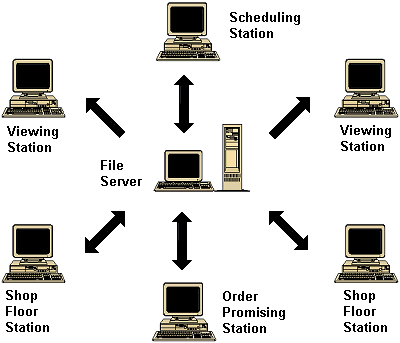TACTIC Configuration
 TACTIC's interactive what-if approach to helping management teams find and solve problems requires quick and frequent access to computing equipment. Consequently, TACTIC operates both on high-end independent personal computers and also on personal computers that you integrate into a local area, wide area, or World Wide Web network.
TACTIC's interactive what-if approach to helping management teams find and solve problems requires quick and frequent access to computing equipment. Consequently, TACTIC operates both on high-end independent personal computers and also on personal computers that you integrate into a local area, wide area, or World Wide Web network.
Network configuration
A TACTIC network installation provides a central database of inventory, capabilities, requirements, schedule, and status data. Teams can use this data to quickly communicate with and coordinate your various departments as they find and resolve problems. To those ends, they can create, retrieve, and edit the data with TACTIC modules.
- TACTIC Scheduling Modules
- TACTIC Viewing Modules
- TACTIC Order Promising Modules
- TACTIC Shop Floor Modules
TACTIC controls access to the data by security levels. For example, when customer changes, such as hot orders, occur, a scheduling module user can transfer the changes from a business system, reschedule to see any adverse effects, and try what-if ideas to resolve the problems.
Once problems are resolved, the scheduling module user can immediately change the shop floor to-do list for the effected machines. The to-do list is transferred electronically to the appropriate shop floor module users.
The scheduling module user can also electronically update the viewing and order promising module users, such as management, sales, and purchasing. They would be provided the most up-to-date actual and projected order status and other data, such as material requirements.
Viewing users often use the schedule data to answer status questions, try their what-if ideas, and print reports. Order promising users typically use the data to promise delivery for new orders, and for change orders prior to acceptance.
When shop floor change occurs, the shop floor module users can immediately report to the scheduling module user (e.g., quantity complete, breakdown, etc.). The scheduling module user can then reschedule, for example, to compensate for a breakdown by moving orders to another machine. The scheduling module user can then immediately reflect the changes in new to-do lists electronically sent to the shop floor module users, and also in new status data electronically sent to the viewing and order promising module users.
Independent computer configuration
Many management teams already have good data, procedures, and systems when they are considering TACTIC. They are often seeking to build on their systems and procedures by using TACTIC's what-if, visibility, and flexibility features. These features let them better use and combine their good data to more quickly communicate with and better coordinate their various departments as they find and resolve problems.
For some of these teams, a TACTIC independent personal computer installation might be more appropriate than a TACTIC network installation. For example, they could install a TACTIC scheduling module on a personal computer, which has two-way data transfer capabilities with their existing business system. This would allow them to gather the data TACTIC needs (e.g., orders, inventory, shop floor status, etc.) using your existing procedures and systems. It would also allow them to use their existing systems and procedures to disseminate the valuable data generated by TACTIC, which is based on your finite capacity and material (e.g., to-do lists, status, requirements, etc.). In effect, they would be using TACTIC information to drive their existing procedures and systems, rather than using TACTIC's viewing, order promising, and shop floor modules.
